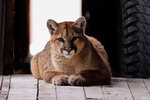Cloudy, 54° F
Wyoming is moving ahead with plans to more intensively hunt mountain lions in northwestern parts of the state where winter walloped the population of one prey species: mule deer.
The decision …
This item is available in full to subscribers.
The Powell Tribune has expanded its online content. To continue reading, you will need to either log in to your subscriber account, or purchase a subscription.
If you are a current print subscriber, you can set up a free web account by clicking here.
If you already have a web account, but need to reset it, you can do so by clicking here.
If you would like to purchase a subscription click here.
Please log in to continue |
|


Wyoming is moving ahead with plans to more intensively hunt mountain lions in northwestern parts of the state where winter walloped the population of one prey species: mule deer.
The decision results from hunting outfitters pressuring the Wyoming Game and Fish Commission to go after predators after the unusually deadly winter. The Wyoming Game and Fish Department responded in June with a proposal to open up its cougar hunting seasons out of the triennial cycle and increase the cat quota by 50% in four hunt areas — a plan commissioners approved while meeting Wednesday in Gillette.
Ahead of the vote, Game and Fish’s large carnivore supervisor, Dan Thompson, spoke candidly about the likely effect — or lack thereof — of targeting more lions.
“Killing more lions isn’t going to bring back mule deer,” Thompson said.
That statement is supported by a nearly decade-long research project examining the Wyoming Range Mule Deer Herd. Winter mortality and habitat conditions are much more influential factors for the herd than predation, University of Wyoming biologists have found, and lions are one of many species eating deer.
But, Thompson added, the public is pressuring officials “to do something” based on the suppressed mule deer prey population — down by perhaps 60% to 70%. “And this is one time we can increase those [mountain lion] limits,” Thompson said.
While heavier lion hunting is unlikely to help the whole deer herd, Thompson said there will be short-term benefits for some animals from decreased predation.
Commissioners unanimously approved a 50% hike in lion quotas for four hunt areas, making no changes to the agency’s proposal.
The areas encompass the Wyoming and Salt River ranges and tread into portions of the Snake River and Gros Ventre mountain ranges. Specifically, the quota in unit 14 went from a 20-cat limit to 30; unit 17, from five to eight; unit 26, from 15 to 23; and unit 29, from six to nine cats.
The puma population, Thompson said, can absorb a temporary pulse of increased pressure from houndsmen. The higher quotas are likely to turn that portion of northwest Wyoming into a “population sink” where cat numbers will decline, but the agency knows from experience that they’ll likely rebound.
Thompson walked commissioners through lessons learned from letting hunters kill about 40% of the lions annually in southeast Wyoming. After the puma population was knocked down, he said, it took about two years for males to migrate back, and three years for females to fill back in.
“It took about five years to bring the social structure back into place,” Thompson said. “What we found is that mountain lions can respond relatively quickly from a high level of harvest, or reduction.”
The majority of the dozens of people who submitted comments about the state’s lion hunting rule revisions opposed the quota hike. About half, however, were from out of state, and participation at Game and Fish’s public meetings was “pretty paltry,” Thompson said.
Nobody who spoke at the Gillette commission meeting this week supported the quota hike, but two members of the public contested the changes.
“Killing lions gives us the feeling we are in control,” said Penny Maldonado, executive director of the Jackson-based Cougar Fund. “This is a very unsettling slide away from the ecological reality that all wild animals contribute to the environment.”
Mountain lion hunting in western Wyoming began Sept. 1 and goes until March 31. Because the statewide mountain lion regulations were updated in July 2022, and they’re on a three-year cycle, the quotas aren’t scheduled for another revision until 2025.
(WyoFile is an independent nonprofit news organization focused on Wyoming people, places and policy.)